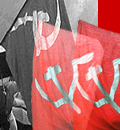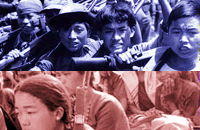
|
|
|
|
|
|
|
|
 |
|
 |
| Analysis |
January 2006, Friedrich-Ebert-Stiftung (FES)
| Cost of Armed Conflict in Nepal: Book Review |
ECONOMIC indicators reveal that the armed conflict has frustratingly aggravated poverty in the country in the recent years. The cost of war has become unbearable day by day.
The country's economy would already have gone into quagmire in the absence of remittances (over 72 billion rupees a year through the official channel alone) that the nation receives from youths working abroad.
However, the economy in the recent months, according to some economists has reached to such a dire straight that it will not sustain even for next few months. The cost in every respect is pilling up on the soldiers of each Nepali.
A survey conducted by Nepal Economic Association (NEA) some one and half years before had disclosed that the cost of insurgency had exceeded over 60 billion rupees. This excludes the cost of human casualties. None of the studies have yet calculated the cost of human casualties.
Referring to a research finding, Prof. Bishwombher Pyakurel says that there has been a two per cent loss in the GDP because of the Maoist Violence. Another study, according to him, talks about 8-10 per cent loss in the GDP. A number of studies have been carried out by the national and international organisations so far. It sometimes appears that the study of cost of conflict has been a common trend among the NGOs and their preferred economists.
Conflict in a sense has given a good paying job to a number of so-called researchers and economists. There are different kinds of research reports on conflict, but the book entitled Cost of Armed Conflict in Nepal is written/edited in different perspective.
Comparing other books on the ongoing conflict, the book is looks more informative and analytical. The book under review is the collection of working papers presented in a seminar organized by the NEFAS.
This is the third publication on conflict by NEFAS. Conflict Resolution and Governance in Nepal and Critical Barriers to the Negotiations of Armed Conflict in Nepal were two other books, which mention the reasons of conflict and its various dimensions relating to negotiations between the conflicting groups.
The present book contains five chapters authored by five different writers. The first chapter written by M. R. Josse is about "Nepal's Conflict and National Security". Josse's working paper vividly explains the political situation that developed after 1990.
Josse a well known journalist has put forward the entire situation in chronological order so that the readers can easily take hold of the political development and draw the conclusion themselves. However, Y. K. Silwal's comment on Josse's paper outlines some lacking.
Silwal has pointed out the role of UN and declined the possibilities of Sikkimization. The first chapter gives the idea about the cause of the Maoist movement.
Josse blames the political parties for creating such a situation. Corruption, bad governance and political instability, according to Josse, were the root causes that vented the frustration of people through the Maoists movement. In his writing Josse has failed to mention a single word about the conspiracy theory being hatched by some political elements.
The second chapter is about Nepal's Conflict Displacement: Causes and Consequences. Bihar Krishna Shrestha in his paper has attempted to highlight some of the causes of conflict. Shaubhagya Shah's view in this chapter supplement the opinions put forth by Shrestha.
Similarly, in the third chapter, Keshav Acharya has presented the consequences of conflict in the economy. But he has not mentioned what sector of the economy has been marred by the violence and conflict. Literal presentation of data does not speak anything about the quantitative aspect.
The fourth chapter written by Khagendra Prasain does not contain any new ideas. For general readers, it is difficult to differentiate Prasain's other working papers with this particular paper. Editors should have been careful about his language as well.
The fifth chapter written by Geeta Sangraula Pathak is not that analytical.
Above all the book would be worth reading for understanding the on going conflict phenomenon in the country.
An institution like NEFAS while publishing a book should be careful about depth of knowledge of the resource persons. It should understand the fact that an institution can no longer function effectively as long as individual interest prevails. Readers would anticipate unbiased approach at least from NEFAS. It should no longer encourage such biased attitude.
Above all the NEFAS has done a tremendous job by publishing such a book. The book is worth reading and useful for researchers and economists. Efforts of NEFAS are surely appreciable.
Source:
The Rising Nepal, Friday Supplement (10 February 2006)
 |
|
 |